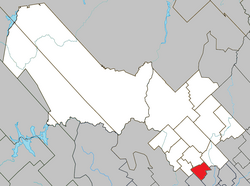Saint-Séverin, Mékinac, Quebec
|
Saint-Séverin Proulxville |
|
|---|---|
| Parish municipality | |
 |
|
 Location within Mékinac RCM. |
|
| Location in central Quebec. | |
| Coordinates: 46°40′N 72°30′W / 46.667°N 72.500°WCoordinates: 46°40′N 72°30′W / 46.667°N 72.500°W | |
| Country |
|
| Province |
|
| Region | Mauricie |
| RCM | Mékinac |
| Constituted | April 11, 1890 |
| Government | |
| • Mayor | Michel Champagne |
| • Federal riding | Saint-Maurice—Champlain |
| • Prov. riding | Laviolette |
| Area | |
| • Total | 61.90 km2 (23.90 sq mi) |
| • Land | 62.28 km2 (24.05 sq mi) |
| There is an apparent contradiction between two authoritative sources |
|
| Population (2011) | |
| • Total | 860 |
| • Density | 13.8/km2 (36/sq mi) |
| • Pop 2006-2011 |
|
| • Dwellings | 394 |
| Time zone | EST (UTC−5) |
| • Summer (DST) | EDT (UTC−4) |
| Postal code(s) | G0X 2B0 |
| Area code(s) | 418 and 581 |
| Highways |
|
Saint-Séverin (also called St-Séverin-de-Proulxville or simply Proulxville) is a parish municipality in Quebec (Canada) in the Mékinac Regional County Municipality, Quebec, in the administrative region of Mauricie and watershed the Batiscanie. At various times, the place was also known as Saint-Séverin-de-Proulxville and Proulxville.
Historically its economy was based mainly on agriculture. Until the mid-20th century, farmers were actively involved in the supply of lumber camps of the Middle and Upper Mauricie, providing men, horses, carriages, meat, flour, fodder, household items ... Two flour mills with a regional upstream of the village contributed significantly to the regional economy.
Population trend:
Private dwellings occupied by usual residents: 378 (total dwellings: 394)
Mother tongue:
According to the conventions of the time, the canonical erection of the parish preceded the civil erection. Prior to 1889, the territory was inhabited and experienced intensive clearing. The Pioneers enjoyed the services of religion at the village of Saint-Stanislas or Saint-Tite. The remoteness of the pioneers made it difficult to practice faith and access to shops and public services in Saint-Tite or Saint-Stanislas. In winter, the pioneers used the ice road over the River des Envies; in other seasons, the roads were bad, especially because of the rain, spring floods and culverts improvised in fund flows. By 1873, the sector's pioneers have made several representations to the Bishop of Trois-Rivières requesting their own parish.
Note that the hamlet Cossetteville (located at the southern end of the Grand Rang Saint-Tite) grew and was popularly regarded as a potential site for a new village for the sector. Religious authorities of the diocese of Trois-Rivières took into consideration the distance between Saint-Stanislas, Saint-Narcisse and Saint-Tite, to facilitate access to the religion.
A railroad section was built to link Saint-Stanislas and Hérouxville. This railroad section started at the Transcontinental stood (east side of Batiscan River) in front of the village of Saint-Stanislas, crossed the river on an iron bridge (located upstream of the village), then roamed the southern part of the municipality of Saint-Séverin, and reached the discharge of Lac-à-la-Tortue (located in Hérouxville). There, the railroad did a big curve of around 90 degrees (in north-west direction) in order to follow the path of chemin de la Grande Ligne (Great line). Finally this railroad section joined (about 1 km west of the village of Hérouxville) the railway line connecting the junction Garneau to Hervey-Junction.
...
Wikipedia

